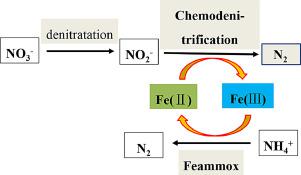Water Research ( IF 12.8 ) Pub Date : 2020-11-12 , DOI: 10.1016/j.watres.2020.116626 Yafei Yang , Cancan Xiao , Qing Yu , Zhiqiang Zhao , Yaobin Zhang

|
A novel ‘anammox’ in the absence of anammox bacteria was confirmed to occur in an anaerobic sludge slurry system, in which Fe(II)/Fe(III) cycle driven by NO2−-induced Fe(II) oxidation and subsequent NH4+-induced Fe(III) reduction (Feammox) pushed the nitrogen removal. Results showed that Fe(II) contents significantly (p<0.05) decreased and Fe(III) accordingly increased with NO2− addition, indicating that Fe(II) was anaerobically oxidized to Fe(III). With depletion of NO2−, the Fe(II) content began to increase which was a result of Feammox. Consequently, 96.0% NH4+-N of the NO2−-added reactor was removed during 18 days operation, while NH4+-N content remained essentially unchanged in the control in which NO2− was not added. X-ray diffraction (XRD) and X-ray Photoelectron Spectroscopy (XPS) analysis indicated that FeOOH was produced from chemical Fe(II) oxidation with NO2−. During the treatment, anammox bacteria was not detected, but the relative abundance of Geobacter of the NO2−-added group increased by 13 folds. Isotope experiment in 15NH4+-containing reactors found that much more 30N2 and 29N2 in the 14NO2−-added group were produced than those in the control (without 14NO2−), confirming that 14NO2− induced Fe(II) oxidation to participate in Feammox for 15NH4+ removal. Also, NO2− could be produced from partial denitrification of NO3−, meaning that NO3− as a more common species might substitute NO2− to trigger this new anammox process.
中文翻译:

使用Fe(II)/ Fe(III)作为催化剂来驱动新型厌氧氨氧化工艺,而无需厌氧氨氧化细菌
在不存在厌氧氨氧化菌的一种新颖的“厌氧氨氧化”证实在厌氧污泥泥浆体系发生,其中的Fe(II)/铁(III)由循环驱动的NO 2 -诱导的Fe(II)氧化和随后的NH 4 +诱导的Fe(III)还原(Feammox)推动了氮的去除。结果表明,铁(II)含量显著(p <0.05)降低和Fe(III)与NO相应地增加2 -另外,指示的Fe(II)在无氧条件下被氧化成Fe(III)。与NO的耗竭2 -的Fe(II)含量开始增加这是Feammox的结果。因此,96.0%的NH 4 +的NO的-N 2 -18天操作期间被删除-增加反应器中,而NH 4 + -N含量保持在没有所述控制基本上保持不变2 -未添加。X射线衍射(XRD)和X射线光电子能谱(XPS)分析表明的FeOOH从化学生产的Fe(II)氧化,NO 2 - 。在处理过程中,未检测到厌氧氨氧化菌,但的相对丰度地杆菌的NO的2 - -增加了组增加了13倍。在15个含NH 4 +的反应堆中进行的同位素实验发现,还有更多的30 N 2和29Ñ 2中14 NO 2 - -增加了组比在对照产生的(无14 NO 2 - ),证实14 NO 2 -诱导的Fe(II)氧化参加Feammox为15 NH 4 +的去除。另外,NO 2 -可以由NO的局部脱氮来生产3 - ,这意味着NO 3 -作为一个更常见的物种可以替代NO 2 -触发此新厌氧氨氧化过程。


























 京公网安备 11010802027423号
京公网安备 11010802027423号